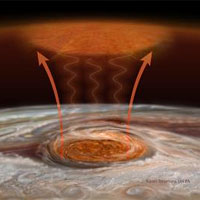Hand-Crank Generator DIY STEM Kit
$9.99$6
Posted on: Aug 10, 2016

Turbulent atmospheric flows above the storm produce both gravity waves and acoustic waves. Gravity waves are much like how a guitar string moves when plucked, while acoustic waves are compressions of the air (sound waves!). Heating in the upper atmosphere 500 miles above the storm is thought to be caused by a combination of these two wave types 'crashing' like ocean waves on a beach
Credit: Art by Karen Teramura, UH IfA with James O'Donoghue and Luke Moore
Researchers from Boston University's (BU) Center for Space Physics report today in Nature that Jupiter's Great Red Spot may provide the mysterious source of energy required to heat the planet's upper atmosphere to the unusually high values observed.
Sunlight reaching Earth efficiently heats the terrestrial atmosphere at altitudes well above the sur-face--even at 250 miles high, for example, where the International Space Station orbits. Jupiter is over five times more distant from the Sun, and yet its upper atmosphere has temperatures, on av-erage, comparable to those found at Earth. The sources of the non-solar energy responsible for this extra heating have remained elusive to scientists studying processes in the outer solar system.
'With solar heating from above ruled out, we designed observations to map the heat distribution over the entire planet in search for any temperature anomalies that might yield clues as to where the energy is coming from,' explained Dr. James O'Donoghue, research scientist at BU, and lead author of the study.
Astronomers measure the temperature of a planet by observing the non-visible, infra-red (IR) light it emits. The visible cloud tops we see at Jupiter are about 30 miles above its rim; the IR emissions used by the BU team came from heights about 500 miles higher. When the BU observ-ers looked at their results, they found high altitude temperatures much larger than anticipated whenever their telescope looked at certain latitudes and longitudes in the planet's southern hemi-sphere.
'We could see almost immediately that our maximum temperatures at high altitudes were above the Great Red Spot far below--a weird coincidence or a major clue?' O'Donoghue added.
Jupiter's Great Red Spot (GRS) is one of the marvels of our solar system. Discovered within years of Galileo's introduction of telescopic astronomy in the 17th Century, its swirling pattern of colorful gases is often called a 'perpetual hurricane.' The GRS has varied is size and color over the centuries, spans a distance equal to three earth-diameters, and has winds that take six days to complete one spin. Jupiter itself spins very quickly, completing one revolution in only ten hours.
'The Great Red Spot is a terrific source of energy to heat the upper atmosphere at Jupiter, but we had no prior evidence of its actual effects upon observed temperatures at high altitudes,' ex-plained Dr. Luke Moore, a study co-author and research scientist in the Center for Space Physics at BU.
Solving an 'energy crisis' on a distant planet has implications within our solar system, as well as for planets orbiting other stars. As the BU scientists point out, the unusually high temperatures far above Jupiter's visible disk is not a unique aspect of our solar system. The dilemma also oc-curs at Saturn, Uranus and Neptune, and probably for all giant exoplanets outside our solar sys-tem.
'Energy transfer to the upper atmosphere from below has been simulated for planetary atmos-pheres, but not yet backed up by observations,' O'Donoghue said. 'The extremely high tempera-tures observed above the storm appear to be the 'smoking gun' of this energy transfer, indicating that planet-wide heating is a plausible explanation for the 'energy crisis.' '
###
The observations reported today and funded by NASA, were analyzed by O'Donoghue and Moore in collaboration with colleagues Thomas Stallard and Henrik Melin from the University of Leicester in the UK. Data taken spanned nine hours on the night of December 4, 2012, at the In-frared Telescope Facility (IRTF) on Mauna Kea, Hawaii, which is operated by the University of Hawaii under contract NNH14CK55B.
Founded in 1839, Boston University is an internationally recognized institution of higher educa-tion and research. With more than 33,000 students, it is the fourth-largest independent university in the United States. BU consists of 16 schools and colleges, along with a number of multi-disciplinary centers and institutes integral to the University's research and teaching mission. In 2012, BU joined the Association of American Universities (AAU), a consortium of 62 leading research universities in the United States and Canada.
 'The true spirit of delight, the exaltation, the sense of being more than Man, which is the touchstone of the highest excellence, is to be found in mathematics as surely as in poetry.'
'The true spirit of delight, the exaltation, the sense of being more than Man, which is the touchstone of the highest excellence, is to be found in mathematics as surely as in poetry.'